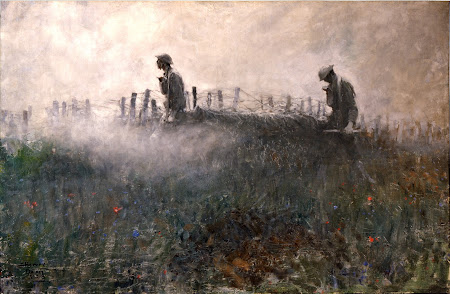Early Modern Exhibit: Influence of WWI
On the Wire by Harvey Dunn 1918, France
Harvey Dunn did a magnificent job when it came to illustrating World War I. Specifically this piece, Dunn makes me feel like I am watching two men carry their fallen comrade across the countryside of France. Even though there are flowers that are blooming, the mist and the fence in the background seem to make me feel more grounded to the reality of what the men went through for their country. The blurred lines of the fence post, and even the soldiers themselves, makes the scene look almost like a dream adding to the feel that the war did not seem real, even to the soldiers fighting. Like it was all a nightmare they were unable escape. Dunn uses the light of the cloudy background to contrast the silhouette of the soldiers to add a sobering effect to the painting. While everything is is muted tones, the only color comes from the speckle of flowers that are scattered across the country side allowing the soldier carrying their fallen comrade to stand out.
World War I is clearly reflected in the piece. Harvey Dunn was an artist known for his sketches while on the front lines during the fighting in France. Because of his first hand experience, Dunn accurately depicted scenes that allowed viewers to understand what men had to go through during the war, like carrying their fallen friend.
Gassed by John Singer Sargent, 1919, Fulham, UK
War is something that should be glamorized and John Singer Sargent does an excellent job when it comes to color, space, and texture. Overall, the painting is a mixture of greens and browns, accurately depicting the uniforms that British soldier wore during World War I, but because the same color palette is used throughout the entire painting, it offers the viewer into a look into how the war effected all soldiers. There is a use of space in the painting that allows for the men in the background to look distant. This makes the men strewn across the ground look as if there are more than there are. In the end, the use of space makes the viewer understand how many soldiers were physically effected by the lethal gas that was used. Lastly, Sargent uses different shading techniques to add an element of texture to the painting. The soldier's clothing is like it is wrinkled and discolored as it would have been in real life.
I love historically accurate art due to how it offers an insight into the reality that people went through. I would own a print of this painting because it is a reminder as to how violence is not the answer and there are catastrophic consequences. Human life can easily be thrown away, and this painting allows me to feel and understand how there are mass casualties in war.
Mustard gas was used to get the enemy out of the trenches without having to risk charging across the open battlefield. Because of how effective and widely used the gas was, thousands of people were killed by using this type of chemical warfare. The painting accurately depicts the loss of life that was derived from the use of chemical warfare.
Harding was known for his depiction of war using charcoal. This piece in particular is interesting because the lighting appears off and the proportions are not necessarily to scale offering the feeling of being very aligned with how war can be seen by some people. I do feel like I am looking at a battle scene that has just occurred and seeing the men rush on through the trenches toward the enemy. The use of more distinct darkened lines used to outline the soldiers compared to the tanks and the barbed wire allow for the eyes to naturally focus on the foreground rather than the background. By utilizing contrast, Harding is able to put more focus on the darker colored soldier rather than the lighter tank that is in the background.
I would own this artwork because it is one of the only pieces I have seen that depicts a tank. Because there is a tank depicted and a lot of other pieces from this time do not have tanks, it makes the piece more unique in my eyes and allows for people to see how World War I was the beginning of a mechanical sort of war when planes and other forms of technology were beginning to be used to fight against one another rather than relying entirely on human brute strength.
Sources:
Jhodges. “World War I Combat Artists – Harvey Dunn.” National Archives and Records Administration, National Archives and Records Administration, 2 Feb. 2015, https://unwritten-record.blogs.archives.gov/2015/02/02/wwi-combat-artists-harvey-dunn/.
Herdrich, Stephanie L. “John Singer Sargent and World War I: Public Art and Personal Loss.” The Metropolitan Museum of Art, 6 Dec. 2017, https://www.metmuseum.org/blogs/now-at-the-met/2017/john-singer-sargent-world-war-i.
Magazine, Smithsonian. “This Riveting Art from the Front Lines of World War I Has Gone Largely Unseen for Decades.” Smithsonian.com, Smithsonian Institution, 12 Aug. 2014, https://www.smithsonianmag.com/smithsonian-institution/remembering-americas-official-artists-war-180952321/.




This collection of art definitely gives an emotional response. The cooler colors give the art a sense of sadness or loneliness. I absolutely love art that gives a big punch to the gut feeling type of emotion. That is what art is supposed to do in my opinion.
ReplyDelete